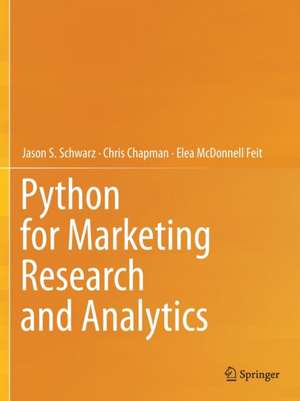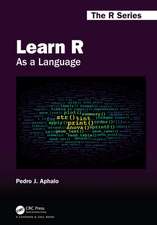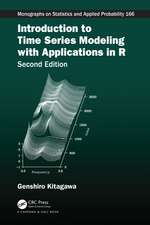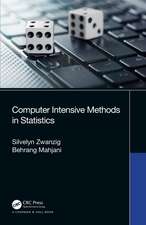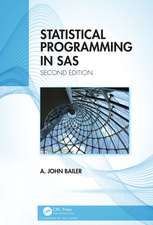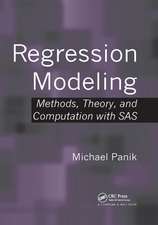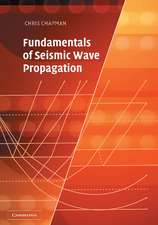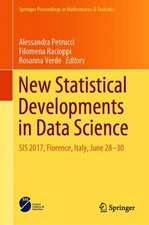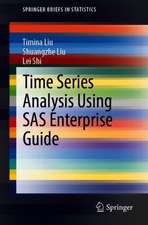Python for Marketing Research and Analytics
Autor Jason S. Schwarz, Chris Chapman, Elea McDonnell Feiten Limba Engleză Paperback – 3 noi 2021
This book is designed for three groups of readers: experienced marketing researchers who wish to learn to program in Python, coming from tools and languages such as R, SAS, or SPSS; analysts or students who already program in Python and wish to learn about marketing applications; and undergraduate or graduate marketing students with little or no programming background. It presumes only an introductory level of familiarity with formal statistics and contains a minimum of mathematics.
| Toate formatele și edițiile | Preț | Express |
|---|---|---|
| Paperback (1) | 464.37 lei 6-8 săpt. | |
| Springer International Publishing – 3 noi 2021 | 464.37 lei 6-8 săpt. | |
| Hardback (1) | 491.88 lei 38-44 zile | |
| Springer International Publishing – 3 noi 2020 | 491.88 lei 38-44 zile |
Preț: 464.37 lei
Nou
Puncte Express: 697
Preț estimativ în valută:
88.89€ • 96.58$ • 74.71£
88.89€ • 96.58$ • 74.71£
Carte tipărită la comandă
Livrare economică 21 aprilie-05 mai
Preluare comenzi: 021 569.72.76
Specificații
ISBN-13: 9783030497224
ISBN-10: 3030497224
Pagini: 272
Ilustrații: XI, 272 p. 90 illus., 79 illus. in color.
Dimensiuni: 210 x 279 x 19 mm
Greutate: 0.65 kg
Ediția:1st ed. 2020
Editura: Springer International Publishing
Colecția Springer
Locul publicării:Cham, Switzerland
ISBN-10: 3030497224
Pagini: 272
Ilustrații: XI, 272 p. 90 illus., 79 illus. in color.
Dimensiuni: 210 x 279 x 19 mm
Greutate: 0.65 kg
Ediția:1st ed. 2020
Editura: Springer International Publishing
Colecția Springer
Locul publicării:Cham, Switzerland
Cuprins
Part I: Basics of Python.- Chapter 1: Welcome to Python.- Chapter 2: The Python Language.- Part II Fundamentals of Data Analysis.- Chapter 3: Describing Data.- Chapter 4: Relationships Between Continuous Variables.- Chapter 5: Comparing Groups: Tables and Visualizations.- Chapter 6: Comparing Groups: Statistical Tests.- Chapter 7: Identifying Drivers of Outcomes: Linear Models.- Chapter 8: Additional Linear Modeling Topics.- Part III Advanced data analysis.- Chapter 9: Reducing Data Complexity.- Chapter 10: Segmentation: Unsupervised Clustering Methods for Exploring Subpopulations.- Chapter 11: Classification: Assigning observations to known categories.- Chapter 12: Conclusion.- Index.
Notă biografică
Jason Schwarz PhD is a Quantitative Researcher at Google and a former systems neurobiologist. His areas of research include perception, attention, motivation, behavioral pattern formation, and data visualization which he studies at scale at Google. Prior to joining Google, he was a data scientist at a startup where he ran analytics and developed and deployed production machine learning models on a Python stack.
Chris Chapman PhD is a Quantitative Researcher at Google, and an author of Chapman & Feit, R for Marketing Research and Analytics (Springer, 2015). In the broader industry, he has served as President of the American Marketing Association’s Practitioner Council, chaired the AMA Advanced Research Techniques Forum in 2012 and 2017, and is a member of several conference and industry committees. Chris regularly presents research innovations and teaches workshops on R, conjoint analysis, strategic modeling, and other analytics topics.
EleaMcDonnell Feit is an Assistant Professor of Marketing at Drexel University and a Senior Fellow of Marketing at The Wharton School. She enjoys making quantitative methods accessible to a broad audience and teaches workshops and courses on advertising measurement, marketing experiments, marketing analytics in R, discrete choice modeling and hierarchical Bayes methods. She is an author of Chapman & Feit, R for Marketing Research and Analytics (Springer, 2015).
Chris Chapman PhD is a Quantitative Researcher at Google, and an author of Chapman & Feit, R for Marketing Research and Analytics (Springer, 2015). In the broader industry, he has served as President of the American Marketing Association’s Practitioner Council, chaired the AMA Advanced Research Techniques Forum in 2012 and 2017, and is a member of several conference and industry committees. Chris regularly presents research innovations and teaches workshops on R, conjoint analysis, strategic modeling, and other analytics topics.
EleaMcDonnell Feit is an Assistant Professor of Marketing at Drexel University and a Senior Fellow of Marketing at The Wharton School. She enjoys making quantitative methods accessible to a broad audience and teaches workshops and courses on advertising measurement, marketing experiments, marketing analytics in R, discrete choice modeling and hierarchical Bayes methods. She is an author of Chapman & Feit, R for Marketing Research and Analytics (Springer, 2015).
Textul de pe ultima copertă
This book provides an introduction to quantitative marketing with Python. The book presents a hands-on approach to using Python for real marketing questions, organized by key topic areas. Following the Python scientific computing movement toward reproducible research, the book presents all analyses in Colab notebooks, which integrate code, figures, tables, and annotation in a single file. The code notebooks for each chapter may be copied, adapted, and reused in one's own analyses. The book also introduces the usage of machine learning predictive models using the Python sklearn package in the context of marketing research.
This book is designed for three groups of readers: experienced marketing researchers who wish to learn to program in Python, coming from tools and languages such as R, SAS, or SPSS; analysts or students who already program in Python and wish to learn about marketing applications; and undergraduate or graduate marketing students with little or no programming background. It presumes only an introductory level of familiarity with formal statistics and contains a minimum of mathematics.
This book is designed for three groups of readers: experienced marketing researchers who wish to learn to program in Python, coming from tools and languages such as R, SAS, or SPSS; analysts or students who already program in Python and wish to learn about marketing applications; and undergraduate or graduate marketing students with little or no programming background. It presumes only an introductory level of familiarity with formal statistics and contains a minimum of mathematics.
Caracteristici
Introduces Python specifically for advanced quantitative marketing and analytics Presents the concept of shareable reproducible research enabled by notebooks Applies Python to the building of statistical models using open source libraries such as sklearn and statsmodels
